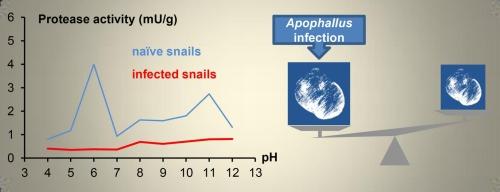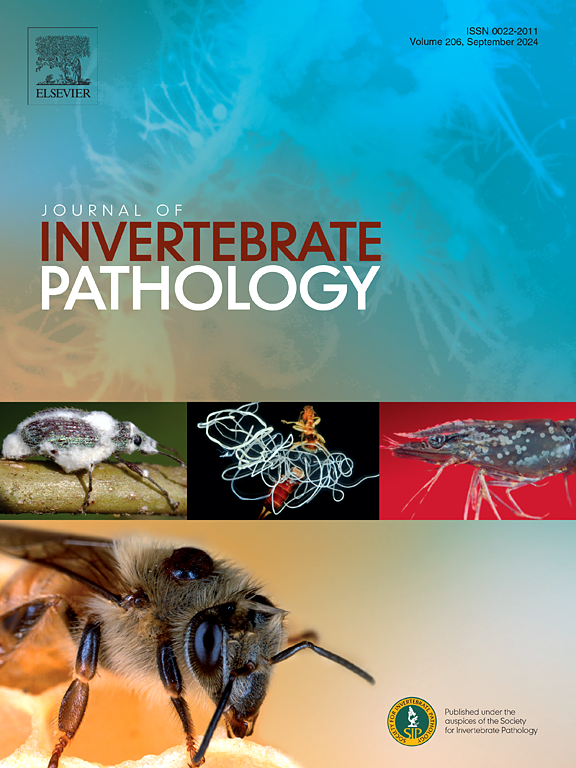刺虫侵染对入侵石螺生长和酶活性的影响。
IF 2.4
3区 生物学
Q1 ZOOLOGY
引用次数: 0
摘要
目前,外来淡水腹足动物Lithoglyphus naticoides正在迅速扩大其活动范围,并促进寄生吸虫Apophallus sp.的传播。这些扁虫以蜗牛为中间寄主,可能导致危险的鱼幼体黑斑病。然而,尽管了解这种宿主-寄生虫相互作用的生理基础具有明显的重要性,但这方面的研究仍然很少。因此,本研究重点研究了白腹草的大小、重量和生理参数及其对阿菲菲斯侵染的响应。结果发现,感染后的软体动物的壳高和总重显著增加。相反,在较宽的pH范围内,感染的蜗牛蛋白酶活性显著低于naïve蜗牛。抑制因子分析表明,该植物具有丝氨酸酶、半胱氨酸酶和金属蛋白酶活性。吸虫感染对丝氨酸蛋白酶的影响最大,降低了它们的活性水平。同时,侵染未引起钉螺α-淀粉酶活性降低。在一定的pH值下,寄生蜂α-淀粉酶活性显著高于非寄生蜂。这些代谢特征可能有助于被寄生宿主的生长加速,从而影响它们的生存和传播,最终可能对水库生态系统产生深远的影响。本文章由计算机程序翻译,如有差异,请以英文原文为准。

Infection with trematodes Apophallus sp. affects the growth and activity of hydrolytic enzymes in the invasive gravel snail Lithoglyphus naticoides
Currently, the alien freshwater gastropod Lithoglyphus naticoides is rapidly expanding its range and promoting the spread of parasitic trematodes Apophallus sp. These flatworms use the snail as intermediate host and may cause the dangerous black-spotted disease in fish juveniles. However, despite the obvious importance of knowing the physiological bases of this host-parasite interplay, studies in this area remain scanty. Therefore we focused on the size-weight and physiological parameters of L. naticoides and their changes in response to Apophallus infection. It was found that the shell height and total body weight significantly increase in the infected molluscs. In contrast, protease activities were significantly lower in infected than in naïve snails over a wide pH range. Inhibitor analysis showed the presence of serine-, cysteine- and metalloproteinase activity in L. naticoides. Trematode infection most strongly affected the serine proteinases, reducing their activity levels. At the same time, the infection did not cause a decrease in α–amylase activity in the gravel snails. Moreover, at certain pH values, α–amylase activity was significantly higher in parasitized than in non-parasitized specimens. These metabolic features may contribute to growth acceleration in parasitized hosts, thereby affecting their survival and spread, which eventually may have far–reaching consequences for the reservoir ecosystems.
求助全文
通过发布文献求助,成功后即可免费获取论文全文。
去求助
来源期刊
CiteScore
6.10
自引率
5.90%
发文量
94
审稿时长
1 months
期刊介绍:
The Journal of Invertebrate Pathology presents original research articles and notes on the induction and pathogenesis of diseases of invertebrates, including the suppression of diseases in beneficial species, and the use of diseases in controlling undesirable species. In addition, the journal publishes the results of physiological, morphological, genetic, immunological and ecological studies as related to the etiologic agents of diseases of invertebrates.
The Journal of Invertebrate Pathology is the adopted journal of the Society for Invertebrate Pathology, and is available to SIP members at a special reduced price.

 求助内容:
求助内容: 应助结果提醒方式:
应助结果提醒方式:


